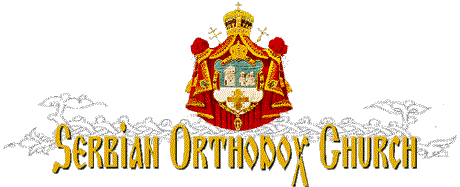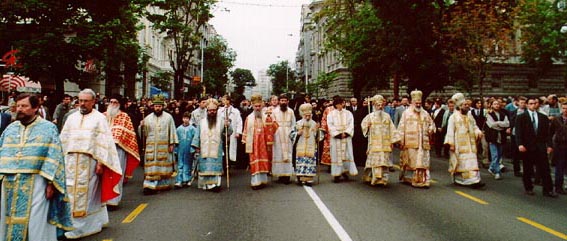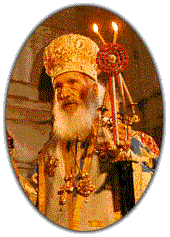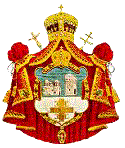










Monastery Chilandar
on Holy Mountain of Athos
in this, 1998 year the Chilandar Monastery celebrates its 800th Anniversary as
the Serbian Orthodox Monastery
| |

The Serbian Orthodox Church is one of the local churches
of the orthodox Christian East. With other orthodox churches it is connected by the unity
of faith, holy fathers' tradition, mutual liturgy-beneficial practice and church
organization. Such division is conditioned by exterior factors but before all by
geographical conditions as well as by the division of mankind into peoples and states.
Local churches get in such a way the national character and connect their destiny with the
destiny of their people. That is how it is with the Serbs.
According to its significance in the history of human civilization, the region of the
Balkans and particularly its Southern part with the islands can be paralleled with the
oldest civilizations of the ancient East. Concerning the first beginnings of the spreading
of Christianity on the Balkans' region it is to be ascertained right away that that
region, among the first ones in the world, entered into the world of the New Testament of
our Lord Jesus Christ. Several epistles of St Apostle Paul (two to Corinthians, two to
Thessalonians, two to Titus - the bishop on Crete and one to Philippians) are directed as
early as in the first half of the lst century to the church communities on the
Balkan, which this Apostle had founded at his Second missionary journey. The furthest
South East of the European Continent was, then, already at the very beginning of the new
Christian era enthusiastic for the Christianity. Thereupon it can be rightly concluded
that the regions of the Balkan peninsula have the Church from the times of Apostles with
the origin of the Apostles as well.

His Holiness, Serbian Patriarch Pavle says: "It was hard to endure but it was
endured because in our soul, out of the depth of centuries, the words of the Son of God
resonded, directed to the end of the world to all believers". Do not be afraid at all
of that which you are to suffer ... Do not be afraid, I am the first and last and alive
and was dead and here I am alive for ever and ever ... Be faithful to the point of death
and I will give you the wreath of life. (Rev 2,10:1,17)

H.H. Pavle, The Serbian Patriarch
Former bishop of Ras-Prizren diocese (Kosovo and Metohija region),
Patriarch Pavle was elected a head of the Serbian Orthodox Church in 1990. His Holiness
did post-graduate studies at the Orthodox Theological Faculty at the University of Athens.
During his stay in Greece, he studied the New Testament and developed an expertize in
liturgics, which resulted in the Patriarch becoming on of the most prolific liturgical
writers in the Serbian Orthodox Church.
For his work in the theology, the Theological Faculty of the Serbian
Orthodox Church awarded His Holiness an honorary doctorate of Divinity. From 1949 to 1955
he was a monastic at the Monastery of Raca, performing different disciplines. During the
1950-51 academic year, the then-Hierodeacon Pavle was appointed a lecturer at the Prizren
Seminary, a position which he retained until his election to patriarchal throne. In 1957
he was elevated to the rank of archimandrite, and in the same year the Holy Assembly of
Bishops elected Archimandrite Pavle as bishop Ras-Prizren.
From that very day until the present, he has faithfully shared in the plight of his
people.

H.H. Pavle, The Serbian Patriarch during a
liturgical procession

Having arrived at the Balkan peninsula the Serbs had, as other South
Slavs, found developed church organizations. According to the narration of Tsar
Constantine Porphirogenite the first mass baptization of the Serbs was in the time of the
Byzantium Tsar Iraklije (610-641). Already in IX century, particularly during the reign of
Prince Mutimir, the vivid missionary activity was developed and the first eparchics in
Serbia are also mentioned. That is why this period is called "the second baptization
of the Serbs". Total consolidation of the Christianity with Serbs really happens only
on the basis of the Slavic sermon and od's service which came into Serbian regions firstly
from Panonic region and then from Slavic church centers in Macedonia and the Coastal
region. On the shores of Ohrid and Prespansko Lake owing to St Clement and St Naum the
Slavic literacy flourished, the clergy was educated, numerous monasticism was developed
and new monasteries were sprouting.

Unfortunately, in the newest history, the sufferings of the Serbian Orthodox Church
and Serbian people are being prolonged. In the areas of ex-Yugoslavia, in the period of
1991-1995 in the war sufferings the brunt was born by 10 eparchics of the Serbian Orthodox
Church, in the region of Croatia by 5 eparchies and in the region of ex-Bosnia and
Herzegovina by 5 eparchies. The Serbian Orthodox Church bore the brunt of two destructive
armies of Croatians and Moslems which were often united. Many churches were burnt own
and plundered and the people again had to run away from their homes. That's how many
historical lights were destroyed and in addition to valuable liturgy objects the whole
galleries of icons on the iconostases were destroyed and the works of known icon painters,
around 5.500 icons were destroyed which is the real national catastrophe. The Museum of
the Serbian Orthodox Church published the book "Spiritual Genocide - the Review of
Destroyed and Damaged Chuches, Monasteries and Other Church Objects in the War of 1991
– 1993".This book is accepted by the Hague Tribunal as the official document.
|
|

|
|
 
|
